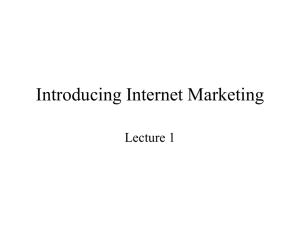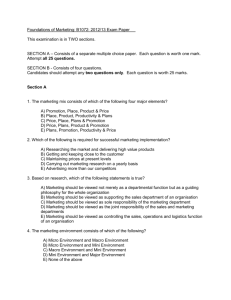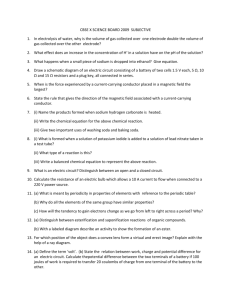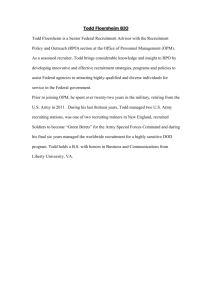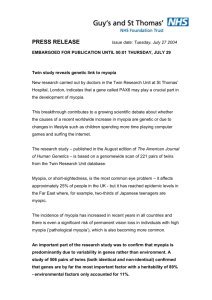Myopia: A Modern Yet reversible Disease
advertisement
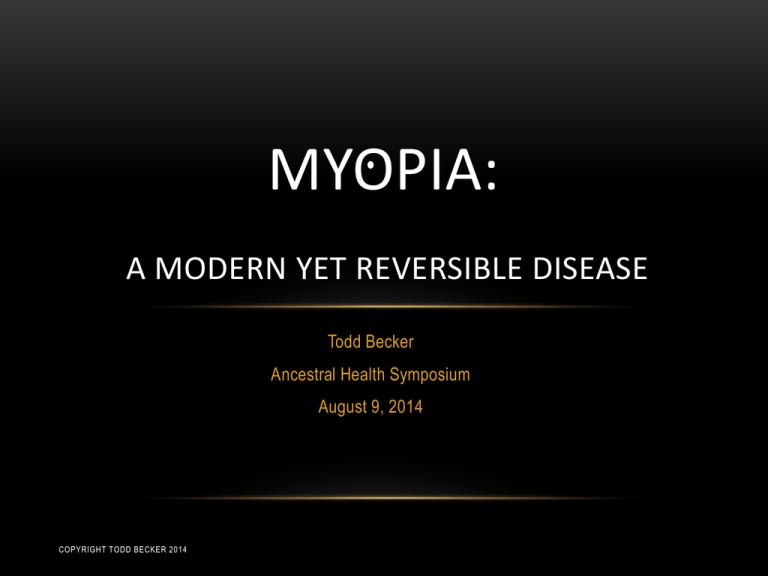
MYOPIA: A MODERN YET REVERSIBLE DISEASE Todd Becker Ancestral Health Symposium August 9, 2014 COPYRIGHT TODD BECKER 2014 MY STORY COPYRIGHT TODD BECKER 2014 TWO QUESTIONS What causes myopia? How can it be reversed? Taipei Times: Singaporean students use iPads in a language arts class at Nanyang Girls’ High School on May 18, 2011 COPYRIGHT TODD BECKER 2014 WHAT CAUSES MYOPIA? Definition: Myopia (nearsightedness) is a refractive defect of the eye, in which distant objects appear blurred because their images are focused in front of the retina, rather than on it. Myopia is the most common refractive error of the eye and is becoming more prevalent. Severe myopia can lead to complications such as: retinal detachment, eye floaters, cataracts and macular degeneration. COPYRIGHT TODD BECKER 2014 MYOPIA HAS INCREASED GREATLY SINCE 1970 Vitale, S. et al., Increased Prevalence of Myopia in the United States Between 1971-1972 and 1999-2004, Arch Ophthalmol. 2009;127(12):1632-1639. COPYRIGHT TODD BECKER 2014 IS IT CAUSED BY GENETICS …OR ENVIRONMENT? Genetic causation - evidence Environmental causation - evidence • More correlated in identical twins than fraternal twins • Large increase among aboriginal peoples after Western schooling • More correlated between parents and children than “by chance” • Correlation between myopia prevalence and academic achievement • Gene mutations associated with severe myopia (SCO2) • • Wide variation between different ethnic groups Experimental demonstration of defocus-induced ocular growth in animals • Asia: 70-90% • Europe/America: 30-40% • Africa: 10-20% Fredrick, Douglas R. (2002). "Myopia", British Medical Journal 3234 (7347): 1195-1199. COPYRIGHT TODD BECKER 2014 MYOPIA AMONG DIFFERENT OCCUPATIONS 1883 survey of military recruits in Holland: Occupation before recruiting Percent myopic Farmers and fishermen 2.45% Handworkers (coarse work) 5.24% Handworkers (fine work) 11.66% Merchants 15.76% Advanced students 32.38% http://www.myopia.org/ebook/10chapter5.htm COPYRIGHT TODD BECKER 2014 INTRODUCTION OF SCHOOLING TO ESKIMOS Barrow Alaska study (1969) Myopia Frequency in Eskimo Age Groups 100 Attended school 90 No school Percent Myopia 80 70 60 50 40 30 20 10 0 6-10 11-15 16-20 21-25 26-30 31-35 36-40 41-45 46-50 51-55 56-60 61-65 66-70 71-88 Age Cohort Young, F.A. (1969) The transmission of refractive errors within Eskimo families. Am. J. Opt and Arch. Am Acad. Opt. 46 COPYRIGHT (9). TODD BECKER 2014 EFFECT OF EDUCATIONAL LEVEL IN GERMANY Study of German students (2012) Myopia increases with more education 60 Percent with Myopia 50 40 30 20 10 0 Dropouts Vocational Secondary University Education Completed Mirshahi, Alireza et al., Myopia and Level of Education, Journal of the American Academy of Ophthalmology (2012). COPYRIGHT TODD BECKER 2014 PREVALENCE IN DIFFERENT COUNTRIES http://osiminspiringlife.wordpress.com/2012/12/03/causes-and-prevention-of-myopia/myopia/ COPYRIGHT TODD BECKER 2014 GENETIC PREDISPOSITION …We performed exome sequencing in 4 individuals from an 11-member family of European descent from the United States. Affected individuals had a mean dioptric spherical equivalent of -22.00 sphere. …SCO2 encodes for a copper homeostasis protein influential in mitochondrial cytochrome c oxidase activity. Copper deficiencies have been linked with photoreceptor loss and myopia with increased scleral wall elasticity. COPYRIGHT TODD BECKER 2014 DIET AND MYOPIA Some studies implicate contribution to myopia from: • Hyperinsulinemia and insulin resistance • Excess intake of carbohydrate and whole grains • Deficiency of fish oil / essential fatty acids • Mineral deficiency or excess (Cu, Zn, Vn) Cordain et al. (2002) • Children in islands of Vanuatu have 8 hours of daily compulsory schooling. • Rate of myopia in Vanuatu children is about 2% • Vanuatuans eat fish, yam and coconut, and no bread or cereals. Cordain L, Eaton SB, Miller JB, Lindeberg S, Jensen C (2002). "An evolutionary analysis of the aetiology and pathogenesis of juvenile-onset myopia". Acta Ophthalmologica Scandinavica 80: 125–135 COPYRIGHT TODD BECKER 2014 HOW ENVIRONMENT ACTS ON GENETICS Environment Genetics Predisposed Not predisposed Myopiagenic (education, near work) Strong myopia > 2.0 diopters > 20/150 Snellen Mild myopia < 2.0 D < 20/150 Snellen Non-myopiagenic No myopia No myopia Fredrick, Douglas R. (2002). "Myopia", British Medical Journal 3234 (7347): 1195-1199. COPYRIGHT TODD BECKER 2014 WHAT IS THE BIOLOGICAL MECHANISM? COPYRIGHT TODD BECKER 2014 THE NORMAL LENS CHANGES SHAPE TO FOCUS Relaxed ciliary muscle Contracted ciliary muscle COPYRIGHT TODD BECKER 2014 HOW MYOPIA PROGRESSES Spasm far far Normal vision near Pseudo myopia Near work u near Minus lens x far v far Axial myopia near COPYRIGHT TODD BECKER 2014 Eye Elongation w Distance “correction” near Defocus INCREMENTAL RETINAL-DEFOCUS THEORY (IRDT) • Axial myopia is a consequence of incremental defocus induced by minus lenses • Time-averaged incremental retinal defocus decreases the rate of of release of neuromodulators responsible for retinal proteoglycan synthesis • This decreases scleral tissue integrity, increasing scleral growth and the eye’s axial length Distance “correction” near Axial myopia Defocus Eye Elongation near w Scleral growth • Repeated cycles of near-work transient myopia lead to an an increase in axial growth that leads to permanent myopia. • Hyperopia results from the opposite process: Focusing in front of the retinal induces the eye globe to grow shorter Hung, G.K., Ciuffreda, K.J. (2003). An incremental retinal-defocus theory of the development of myopia. Comm. Theor. Biol. 8: 511-513 COPYRIGHT TODD BECKER 2014 PROOF OF THE IRDT THEORY Demonstrated in chicks, monkeys….and most recently in humans! 28 adults Eye length measured using optical reflectometry Read, Scott et al. (2010) Human optical axial length and defocus. IOVS, 51 (12) 6262-6260. COPYRIGHT TODD BECKER 2014 0 + HOW CAN MYOPIA BE REVERSED? COPYRIGHT TODD BECKER 2014 HORMESIS • Hormesis is the beneficial response of an organism to a low dose stressor that is otherwise detrimental or lethal at high doses • Hormesis works by activating defense or repair mechanisms • The result is supercompensation and increased resilience to stressors EXAMPLES: Exercise UV radiation Immunization Phytonutrients Calorie restriction Callus formation Cold exposure Barefoot running Heat exposure Active focusing COPYRIGHT TODD BECKER 2014 WEIGHT LIFTING IS A GOOD EXAMPLE OF HORMESIS • Lifting heavy objects causes micro-trauma: damage and tearing of muscle fibers • If performed prudently, muscle repair results in supercompensation and hypertrophy • Optimal training occurs at “the edge of failure” SAID Principle: Specific Adaptation to Imposed Demand HOW DOES THIS APPLY TO REVERSING MYOPIA? COPYRIGHT TODD BECKER 2014 WHAT IF GYMS HAD THE SAME BUSINESS MODEL AS OPTOMETRISTS? CONCORD, Massachusetts, December 9, 2004 Schilling Robotics, LLC, is using SolidWorks 3D mechanical design software to design critical parts of an “exoskeleton” that will someday help soldiers, firefighters, rescue workers, and others carry backbreaking burdens without feeling the weight. The BLEEX consists of a backpack-like frame and mechanical braces connected to the user’s feet, legs, and hips. Human users wearing the BLEEX can carry a 70-pound backpack yet feel as though they are carrying five pounds. COPYRIGHT TODD BECKER 2014 HORMESIS FOR THE EYES: USING ACTIVE FOCUS TO REVERSE MYOPIA While reading: • Print pushing and plus lenses For distance: • Progressively weaker lenses • Fusing ghosted images COPYRIGHT TODD BECKER 2014 MEASURING MYOPIA WITH A SNELLEN CHART COPYRIGHT TODD BECKER 2014 PRINT PUSHING With or without glasses • If your correction is more than -2.00 D, no glasses are needed • If your correction is less than -2.00 D, use plus lenses. Select plus lenses that allow you to read at 15-20” from screen or book • When you have to sit more than 20” away, graduate to stronger plus lenses! • Test your vision each week, using a Snellen chart at 20 feet in bright light • Keep going until you reach your goal…20/20 or even 20/15! COPYRIGHT TODD BECKER 2014 PRINT PUSHING D1 D2 D3 COPYRIGHT TODD BECKER 2014 PRINT PUSHING Technique D1 1. Move back from screen or book until you are at the edge of blur (D2) 2. Periodically blink and attempt to bring the print to the edge of focus (D1) D2 3. Read between D1 and D2, adjusting distance as necessary 4. Do this for 2-4 hours daily, taking breaks every 15-30 minutes 5. Increase distance until it exceeds 20” D3 COPYRIGHT TODD BECKER 2014 6. Graduate to stronger plus lenses and repeat until you can read 20/20 DISTANCE: PROGRESSIVELY WEAKER LENSES Zennioptical.com For distance activities, buy lenses that are progressively weaker by 0.5 diopters Successively reduce in 0.5 diopter steps • Walking • TV • Movies • Meetings and lectures • Riding as a passenger Orfield, Antonia. Seeing space: undergoing brain re-programming to reduce myopia. Journal of Behavioral Ophthalmology 5 (5) , 123-131. COPYRIGHT TODD BECKER 2014 TAKING ADVANTAGE OF DIPLOPIA SHARP COPYRIGHT TODD BECKER 2014 BLURRED GHOSTED FUSING GHOSTED IMAGES COPYRIGHT TODD BECKER 2014 FUSING GHOSTED IMAGES COPYRIGHT TODD BECKER 2014 FUSING GHOSTED IMAGES COPYRIGHT TODD BECKER 2014 HOW TO STRENGTHEN YOUR WEAKER EYE Block the dominant eye in order to work the weaker eye: patch COPYRIGHT TODD BECKER 2014 shield wink FREQUENTLY ASKED QUESTIONS • How much time should I spend each day? • How long before my vision improves? • Is this the same as the Bates Method? • Does this method really work? COPYRIGHT TODD BECKER 2014 HOW MUCH TIME SHOULD I SPEND ON THIS? GUIDELINES 1. Print pushing and active focus are not “exercises” – integrate them into your routine 2. Spend at 2-4 hours daily print pushing (with plus lenses if myopia is less than -2.0 D) 3. Take breaks every 15-30 minutes. Alternate between looking at objects near and far. 4. Print pushing should feel “awkward” but never painful. 5. If you ever experience strain or redness, take a break for a day or two COPYRIGHT TODD BECKER 2014 HOW LONG BEFORE MY VISION IMPROVES? MINDSET • Be patient – it takes months to reverse a condition that was years in the making! • Approach active focus the way you would any serious exercise, diet or lifestyle change • Your motivation: Crystal clear distance vision without glasses or contacts! TYPICAL RESULTS 1. Most people see some improvement within a few weeks 2. The rate of improvement is generally faster in the beginning, then slows 3. It is common to see no change for weeks, then sudden big improvements 4. The excitement comes when you start seeing sharp images in the distance! COPYRIGHT TODD BECKER 2014 IS THIS THE SAME AS THE BATES METHOD? Bates was wrong about the physiology of myopia. • He thought that the eye’s focusing mechanism was controlled by muscles surrounding the eye. • We now know it is the ciliary muscle that changes only the shape of the lens. Bates developed some relaxation techniques that might help reverse pseudo-myopia (ciliary strain) but probably do nothing for axial myopia Beyond Bates : • Relaxation and distance viewing are great, but this is not very helpful advice for those of use who must spend a lot of time reading and at the computer • Active focusing at “the edge of blur” provides a way reverse myopia while reading! COPYRIGHT TODD BECKER 2014 DOES ACTIVE FOCUS REALLY WORK? • It has worked for me… and for many others • For success stories, check out gettingstronger.org: 1.3 million views • “Improve vision – and throw away your glasses”: 165,000 views • “Eyesight without glasses” on the Discussion Forum: 132,000 views COPYRIGHT TODD BECKER 2014 REFERENCES Epidemiology 1. Filip, Iulia (2014). "Nearsightedness and the indoor life." Atlantic Monthly, May 2 2. Fredrick, Douglas R. (2002). "Myopia", British Medical Journal 3234 (7347): 1195-1199. 3. Mirshahi, Allreza et al. (2013) Myopia and Level of Education, Manuscript 2013 -717, Am. Acad. Opthal. Annual Meeting, November 2012. 4. Vitale, Susan et al. (2009) Increase prevalence of myopia in the United States between 1971 -1972 and 1999-2004. Arch. Opthalmol. 127 (12): 1632-1639. 5. Young, F.A. (1969) The transmission of refractive errors within Eskimos families. Am. J. Opt. and Arch. Am. Acad. Opt. 46 (9) 676-685. Biological Mechanism 1. Birnbaum, M.H. (1988). Myopia and near-point stress model. In Myopia & Nearwork. Butterworth Heinemann. 2. Drexler, W. et al. (1998). Eye elongation during accommodation in humans. Investigative Opthalmology & Visual Science. 39 (11 ) 2140-2147 3. Hung, L.F., et al. (1995) Spectacle lenses alter eye growth and the refractive status of young monkeys. Nature Medicine, (1) 761-765 4. Hung, G.K., Ciuffreda, K.J. (2003). An incremental retinal-defocus theory of the development of myopia. Comm. Theor. Biol. 8: 511513 5. Irving, E.L., et al. (1991). Inducing myopia, hyperopia and astigmatism in chicks. Opt. Vis. Sci., (68): 364- 368. 6. Read, Scott A. et al. (2010) Human optical axial length and defocus. IOVS, 51 (12) 6262 -6269. 7. Schaeffel, Frank et al. (1988). Accommodation, refractive error and eye growth in chickens. Vision Research. 28 (5) 639 -657. COPYRIGHT TODD BECKER 2014 REFERENCES Methods 1. Brown, Otis S. How to Avoid Nearsightedness--A Scientific Study of the Eye's Behavior. C&O Research, 1999 2. DeAngelis, David, The Secret of Perfect Vision: How You Can Prevent or Reverse Nearsighedness. Berkeley: North Atlantic Books, 2008. 3. Orfield, Antonia. Seeing space: undergoing brain re-programming to reduce myopia. Journal of Behavioral Ophthalmology 5 (5) , 123-131. 4. Severson, Brian. Vision Freedom, 1998 Websites • gettingstronger.org • frauenfeldclinic.com • myopiafree.com • powervisionsystem.com • myopiacure.blogspot.ca COPYRIGHT TODD BECKER 2014 SO….REDISCOVER YOUR NATURAL VISION Your eyes are adaptive organs • Years of closely reading books, computers and smart phones shorten your focal distance • Progressively stronger lens prescriptions make the eye grow longer, increasing myopia But you can use that same adaptability to reverse the process using active focus! • Stimulate your eyes by spending time at the threshold between focus and slight blur • Use plus lenses when reading close up, weakened prescriptions for distance • Keep moving back to increase focal distance… use Snellen measurements to check progress! • Take frequent time out from close up work to focus on distant objects COPYRIGHT TODD BECKER 2014 SO….REDISCOVER YOUR NATURAL VISION Have fun with active focusing. Build it into your daily life -…make it a habit …make it a game! You only have your glasses to lose! COPYRIGHT TODD BECKER 2014 QUESTIONS? http://www.dailymail.co.uk/news/article-2235716/Spear-fisherman-catches-fish-mid-air-New-Caledonia.html COPYRIGHT TODD BECKER 2014

